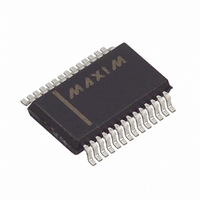MAX1464AAI+ Maxim Integrated Products, MAX1464AAI+ Datasheet - Page 18

MAX1464AAI+
Manufacturer Part Number
MAX1464AAI+
Description
IC SENSOR SIGNAL COND 28-SSOP
Manufacturer
Maxim Integrated Products
Type
Signal Conditionerr
Datasheet
1.MAX1464AAI.pdf
(47 pages)
Specifications of MAX1464AAI+
Input Type
Analog
Output Type
Logic
Interface
SPI
Current - Supply
890µA
Mounting Type
Surface Mount
Package / Case
28-SSOP
Lead Free Status / RoHS Status
Lead free / RoHS Compliant
Low-Power, Low-Noise Multichannel
Sensor Signal Processor
Every function of the DOP module can be selected individ-
ually (DAC, PWM, or op amp), or two out of the three func-
tions of the DOP module can be selected at the same time
(PWM and op amp, or DAC and PWM, or DAC and op
amp), as there are only two output pins for the module,
OUTnSM and OUTnLG. The various configuration options
for the DOP are shown in Table 21. The PWRDAC and
PWROP bits are in the power-on control register (address
= 31h), and the remaining bits are in the DOP registers.
See Tables 21 through 27.
The timer module (Figure 6) comprises a 12-bit counter, a
4-bit prescalar, and control and configuration registers.
When the timer is enabled and initiated, the system master
clock, MCLK, is prescaled by the divisor set by PS[3:0] in
the TMR_Config register and the result applied to the 12-
bit upcounter. When the counter value matches the time-
out value TO[11:0] in register TMR_Config, bit TMDN is set
to 1. The CPU can poll the timer done bit TMDN to check
its status.
The timer module provides a feature that enables the CPU
to be put into a low-power halt mode for the duration of the
timer interval. Setting the ENAHALT bit in the TMR_Control
register while starting the timer (setting the timer enable bit
TMEN to 1), or while the timer is already enabled and
counting halts the CPU at the present instruction until the
TMDN bit becomes set by the counter. The CPU com-
mences execution with the next instruction. All CPU regis-
ters and ports are fully static and retain all data during the
elapsed time interval.
The time interval between TMEN being set to 1, and
TMDN being set to 1 can be computed as follows:
The maximum time interval given f
786ms.
Figure 6. Timer Module
18
TMR_Control
TMR_Config
______________________________________________________________________________________
Time Interval = (2 / f
20h
21h
x (timeout value TO[11:0]) + 1.5}
OSC
) x {(prescale value N)
12-BIT COUNTER
TIMEOUT VALUE
PRESCALER
OSC
Timer Module
= 4MHz clock is
MCLK
The power to various subcircuits in the MAX1464 can be
turned on and off by CPU control and by the serial inter-
face. Unused subcircuits and modules can be turned off
to reduce power consumption. The default state after
power-on is all subcircuits and modules powered off.
This enables low-power embedded systems to turn on
only the needed modules after exiting a low-power CPU
halt timer interval. Modules can be turned on and off as
needed; however, care must be exercised to allow for
module initialization and settling prior to use.
The MAX1464 has a fully integrated oscillator with a
nominal 4MHz frequency. An external clock source can
be used when the clock-select pin CKSEL = 0, operating
all internal timing functions. CKIO can also be configured
as an output source of the internal oscillator clock.
The MAX1464 contains two general-purpose digital
input/output (GPIO) modules, GPIO1 and GPIO2, which
can be written and read by CPU control and by the ser-
ial interface. These two I/O pins operate independently
of each other. They can be configured as inputs, out-
puts, or one input and one output. When configured as
an input, there are two modes of sensing digital inputs;
as a voltage or logic level, or as an edge detector. In
edge-detector mode, either a rising or falling edge can
be selected for detection. A bit is set in the GPIO con-
trol register upon detection of the selected edge.
The GPIO pins have nominal 100kΩ pulldown resistors
to V
logic level when the pin is unconnected. The GPIO may
also serve as an input pin and its state is read from the
GPIO control register (Tables 28 and 29). When using
the GPIO pin as a general-purpose output, its output
state is defined by writing to the GPIO control register.
The GPIOn pins can be configured as an alert output
that goes low or high whenever a fault condition hap-
pens, e.g., remote sensor line disconnection, overflow
conditions in the CPU program execution, etc.
All input and output control for the GPIO1 and GPIO2
pins are contained in GPIO1_Control (address = 40h)
and GPIO2_Control (address = 41h), respectively.
Figure 7 shows the GPIO1 and GPIO2 modules.
The MAX1464 serial interface is a high-speed asyn-
chronous data input and output communication port,
providing access to internal registers for calibration of
embedded control sensor systems. All the FLASH
memory is read and write accessible by the serial inter-
SS
Serial Interface Timing and Operation
as in Figure 6. Pulldown resistors provide a low
Oscillator Control
Power Control
GPIO Module











